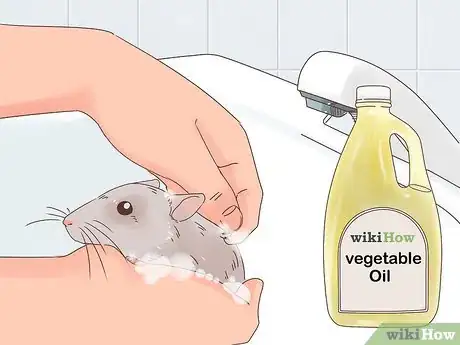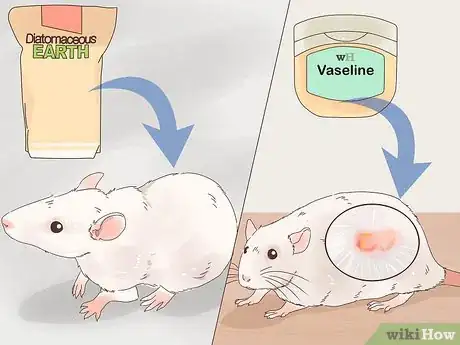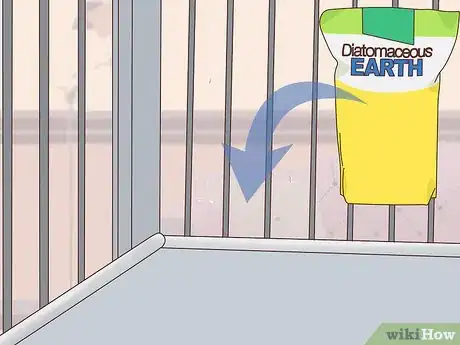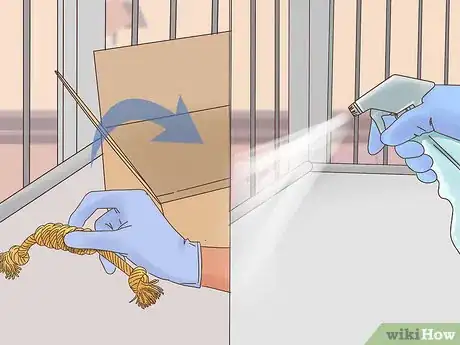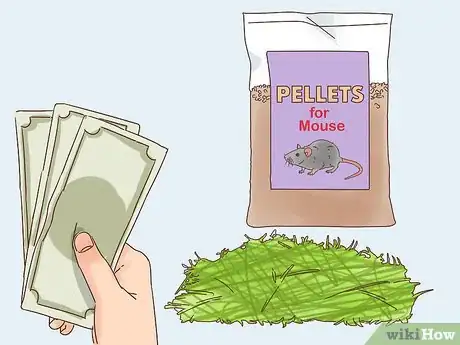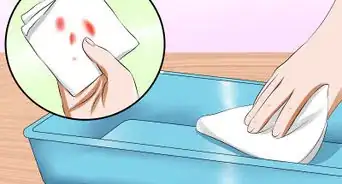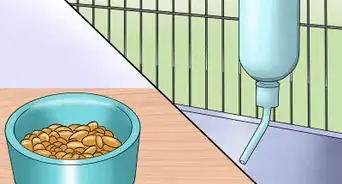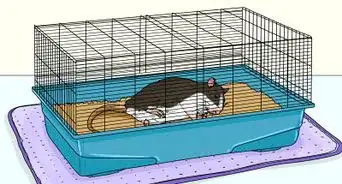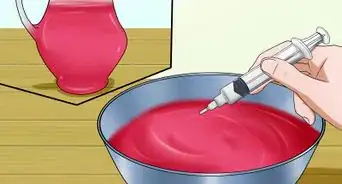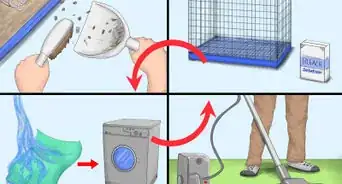This article was co-authored by Pippa Elliott, MRCVS. Dr. Elliott, BVMS, MRCVS is a veterinarian with over 30 years of experience in veterinary surgery and companion animal practice. She graduated from the University of Glasgow in 1987 with a degree in veterinary medicine and surgery. She has worked at the same animal clinic in her hometown for over 20 years.
There are 7 references cited in this article, which can be found at the bottom of the page.
This article has been viewed 44,586 times.
Your pet rat is smart, cuddly, and the center of your world. So when it gets parasites such as mites or lice, you want to jump into action. Keep an eye out for scabs and excessive itching, which may be signs of these pesky hitchhikers. Silver nits or tiny yellow or tan bugs often indicate lice specifically. We'll show you how to treat any external parasites with both medical and alternative solutions. Just be sure you see a vet before you try any at-home care!
Things You Should Know
- Wash your pet rat in vegetable oil to smother mites and lice. Then, rinse them in dish detergent diluted with water.
- Wash and disinfect your rat's cage with diluted bleach, then rinse it with water. Replace any bedding or used food.
- Speak with a vet about using medication such as Xenex, Ivermectin, or Revolution.
Steps
Using Medication
-
1Use a small amount of Xenex topical solution. This solution is formulated for small animals, making it a better option for your rat. Follow the directions on the label to measure out a small amount of the solution, then apply it to your rat's coat. Monitor the rat to make sure it doesn't eat the product.[1]
- Talk to your vet before giving any medications to your rat.
-
2Feed your rat a very small amount of Ivermectin paste with caution. Ivermectin paste is typically used for horses, but it can treat mites and lice on rats, too. However, it's easy to overdose your rat, so use caution. Ivermectin paste is available without a veterinarian's prescription on Amazon or in farm stores.[2]
- Although it's available over-the-counter, you should talk to your vet before giving your rat any type of medication. Remember, safer options, such as Xenex, are available.
- Some mites have developed resistance to Ivermectin. However, it’s good to give Ivermectin a try before going to a veterinarian.[3]
- Be very careful with Ivermectin dosing in rats since an overdose can cause seizures and other neurological problems. Rats weighing 1 pound or more should be given a dose that’s the size of a small, uncooked, grain of rice, once per week for 3 to 4 weeks. Rats weighing less than 1 pound should receive a dose half that size.
- Place the correct amount of Ivermectin paste on a tiny, bite-sized, piece of bread for the rat to eat.[4] If you have multiple rats, dose them separately to make absolutely sure they don't eat each other's medication.
Advertisement -
3Use Revolution to treat mites, lice, and fleas under a vet's supervision. Revolution is a topical liquid medication that comes in a tube and is only available with a prescription from your veterinarian. A single application of Revolution is often all that is needed to eliminate parasites, but sometimes a second treatment after 30 days may be necessary.[5] However, rat's cannot have much of the medication, so it's not the safest option.
- Rats must have very small doses of Revolution to avoid poisoning the animal. Consult with your veterinarian, and carefully follow your veterinarian’s advice regarding dosing and administration.[6]
- Do not apply Revolution to rats immediately after bathing them. Allow their skin and fur to dry completely before application.[7]
- Do not use Revolution on sick or malnutritioned rats, or on rats that are under 5 weeks old. [8] Instead, use non-medicinal alternatives on these types of rats.
Using Non-Medicinal Alternatives
-
1Coat your rat in vegetable oil to smother the living mites and lice. Then after five minutes, gently wash the rat with non-concentrated Dawn dish detergent twice. This eliminates excess oil, dead bugs, dirt, and parasite droppings. It also cleans any wounds caused by the parasite infestation.[9]
- Repeat this once per week for 8 weeks since the life cycle of the parasites lasts that long.
- In order for this to work, you need to clean out your rat's cage and treat it, as well. The oil will not act as a repellent, so the mites or lice will re-infest your rat if the cage is still infested.
- Dawn dish detergent is the brand most trusted to clean animals because it effectively removes oil on animals without hurting them.[10]
-
2Cover your rat with diatomaceous earth, and apply Vaseline to the scabby areas. Diatomaceous earth causes parasites to dehydrate, while the Vaseline suffocates the insects so they cannot breathe. Make sure to use food grade diatomaceous earth in case your rat ingests it.[11]
- Diatomaceous earth are fossilized, ground sea shells that are harmful to parasites and their eggs, but are completely harmless to rats.[12]
- The Vaseline can be applied on scabs immediately after applying the diatomaceous earth. Apply an ample amount of Vaseline to cover all scabby areas. There's no need to wash off the Vaseline or diatomaceous earth.
- Repeat this once per week for 8 weeks to ensure all parasites will be killed.
-
3Coat all trafficked areas of your rat’s cage with diatomaceous earth. Use food grade diatomaceous earth so that your rat won’t be harmed by eating it. Diatomaceous earth kills parasites, but it won't harm your rat.
- If your rats ingest food grade diatomaceous earth, don’t worry! Ingestion can eliminate internal parasites and even supply your rats with trace minerals and nutrients, such as silica.[13]
- Since it won't hurt your rat, your rat can be inside the cage as you coat it with diatomaceous earth.
-
4Empty your rat’s cage, and clean and sanitize the contents. Throw out anything inside the cage that’s wooden or cardboard. Also discard the bedding and food currently in the cage. Then disinfect your rat’s cage and all toys with a bleach solution.[14]
- Create a 10% bleach solution to clean your rat’s cage by mixing 9 parts water with 1 part bleach.[15] Make sure you keep your rat away from the cage while you’re cleaning it with the bleach solution, and then rinse the solution off with water and dry the cage to make sure all chemicals are removed before placing your rat back into its cage.
- It’s also recommended that you use a bleach and water solution on any used items before you bring them into your rat’s cage.[16]
-
5Buy your rats clean, fresh bedding and new food. Rats can become reinfested if the parasites have infiltrated the rat’s bedding and food. Purchase new bedding and food to prevent this.
- To be extra safe, freeze all new food and bedding inside of a freezer for 24 hours before you place them in your rat's cage. Freezing all new purchases will kill any parasites that might be latching onto them. [17]
Expert Q&A
-
QuestionHow do you get rid of fleas on a rat?
 Pippa Elliott, MRCVSDr. Elliott, BVMS, MRCVS is a veterinarian with over 30 years of experience in veterinary surgery and companion animal practice. She graduated from the University of Glasgow in 1987 with a degree in veterinary medicine and surgery. She has worked at the same animal clinic in her hometown for over 20 years.
Pippa Elliott, MRCVSDr. Elliott, BVMS, MRCVS is a veterinarian with over 30 years of experience in veterinary surgery and companion animal practice. She graduated from the University of Glasgow in 1987 with a degree in veterinary medicine and surgery. She has worked at the same animal clinic in her hometown for over 20 years.
Veterinarian There are several effective medicated powders or drops available which are suitable for rats. Those most readily available contain either permethrin or ivermectin. Only use those specifically formulated for small mammals as an overdose is toxic.
There are several effective medicated powders or drops available which are suitable for rats. Those most readily available contain either permethrin or ivermectin. Only use those specifically formulated for small mammals as an overdose is toxic. -
QuestionCan mites kill rats?
 Pippa Elliott, MRCVSDr. Elliott, BVMS, MRCVS is a veterinarian with over 30 years of experience in veterinary surgery and companion animal practice. She graduated from the University of Glasgow in 1987 with a degree in veterinary medicine and surgery. She has worked at the same animal clinic in her hometown for over 20 years.
Pippa Elliott, MRCVSDr. Elliott, BVMS, MRCVS is a veterinarian with over 30 years of experience in veterinary surgery and companion animal practice. She graduated from the University of Glasgow in 1987 with a degree in veterinary medicine and surgery. She has worked at the same animal clinic in her hometown for over 20 years.
Veterinarian This is a chicken and egg scenario. Illness due to mites often occurs because the rat isn't in the best of health or is stressed. The sicker the rat, the higher the risk of infection, so a rat with lots of mites may die but this is most likely because they had a serious underlying health problem.
This is a chicken and egg scenario. Illness due to mites often occurs because the rat isn't in the best of health or is stressed. The sicker the rat, the higher the risk of infection, so a rat with lots of mites may die but this is most likely because they had a serious underlying health problem. -
QuestionCan I get lice from my pet rat?
 Pippa Elliott, MRCVSDr. Elliott, BVMS, MRCVS is a veterinarian with over 30 years of experience in veterinary surgery and companion animal practice. She graduated from the University of Glasgow in 1987 with a degree in veterinary medicine and surgery. She has worked at the same animal clinic in her hometown for over 20 years.
Pippa Elliott, MRCVSDr. Elliott, BVMS, MRCVS is a veterinarian with over 30 years of experience in veterinary surgery and companion animal practice. She graduated from the University of Glasgow in 1987 with a degree in veterinary medicine and surgery. She has worked at the same animal clinic in her hometown for over 20 years.
Veterinarian The lice that infect rats are species-specific. This means they only thrive on rodents and don't pose a risk to people.
The lice that infect rats are species-specific. This means they only thrive on rodents and don't pose a risk to people.
Warnings
- If your rat is pregnant, malnourished, sick, or under 5 weeks old, consult with your veterinarian before giving your rat any medications.⧼thumbs_response⧽
References
- ↑ http://www.noahcompendium.co.uk/?id=-450517
- ↑ http://understandingpetfancyrats.com/2015/12/19/my-rat-has-lice-or-mites-how-do-i-get-rid-of-them/
- ↑ http://understandingpetfancyrats.com/2015/12/19/my-rat-has-lice-or-mites-how-do-i-get-rid-of-them/
- ↑ http://ratguide.com/meds/anti-infectives/ivermectin.php
- ↑ http://ratguide.com/meds/anti-infectives/selamectin_revolution.php
- ↑ http://understandingpetfancyrats.com/2015/12/19/my-rat-has-lice-or-mites-how-do-i-get-rid-of-them/
- ↑ http://ratguide.com/meds/anti-infectives/selamectin_revolution.php
- ↑ http://ratguide.com/meds/anti-infectives/selamectin_revolution.php
- ↑ http://understandingpetfancyrats.com/2015/12/19/my-rat-has-lice-or-mites-how-do-i-get-rid-of-them/
- ↑ https://www.npr.org/templates/story/story.php?storyId=127999735
- ↑ http://understandingpetfancyrats.com/2015/12/19/my-rat-has-lice-or-mites-how-do-i-get-rid-of-them/
- ↑ http://understandingpetfancyrats.com/2015/12/19/my-rat-has-lice-or-mites-how-do-i-get-rid-of-them/
- ↑ http://understandingpetfancyrats.com/2015/12/19/my-rat-has-lice-or-mites-how-do-i-get-rid-of-them/
- ↑ http://understandingpetfancyrats.com/2015/12/19/my-rat-has-lice-or-mites-how-do-i-get-rid-of-them/
- ↑ https://www.thesprucepets.com/can-you-use-bleach-to-clean-cages-1238788
- ↑ http://understandingpetfancyrats.com/2015/12/19/my-rat-has-lice-or-mites-how-do-i-get-rid-of-them/
- ↑ http://understandingpetfancyrats.com/2015/12/19/my-rat-has-lice-or-mites-how-do-i-get-rid-of-them/
- ↑ http://ratguide.com/care/environment/cage_cleaning.php


